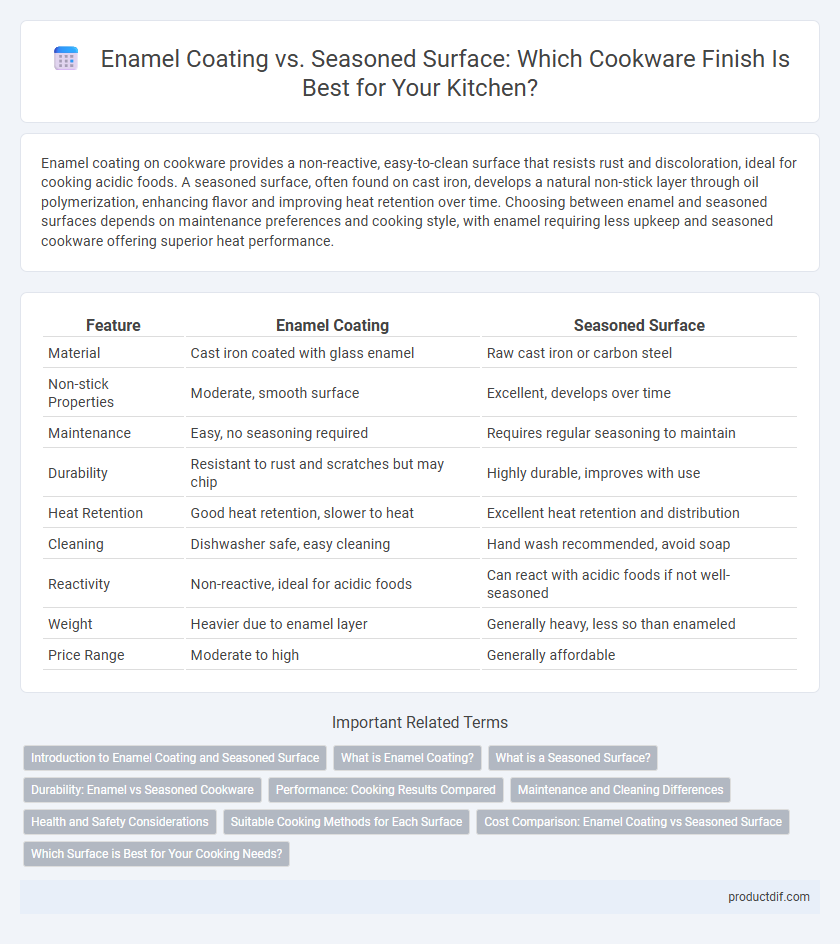Enamel coating on cookware provides a non-reactive, easy-to-clean surface that resists rust and discoloration, ideal for cooking acidic foods. A seasoned surface, often found on cast iron, develops a natural non-stick layer through oil polymerization, enhancing flavor and improving heat retention over time. Choosing between enamel and seasoned surfaces depends on maintenance preferences and cooking style, with enamel requiring less upkeep and seasoned cookware offering superior heat performance.
Table of Comparison
| Feature | Enamel Coating | Seasoned Surface |
|---|---|---|
| Material | Cast iron coated with glass enamel | Raw cast iron or carbon steel |
| Non-stick Properties | Moderate, smooth surface | Excellent, develops over time |
| Maintenance | Easy, no seasoning required | Requires regular seasoning to maintain |
| Durability | Resistant to rust and scratches but may chip | Highly durable, improves with use |
| Heat Retention | Good heat retention, slower to heat | Excellent heat retention and distribution |
| Cleaning | Dishwasher safe, easy cleaning | Hand wash recommended, avoid soap |
| Reactivity | Non-reactive, ideal for acidic foods | Can react with acidic foods if not well-seasoned |
| Weight | Heavier due to enamel layer | Generally heavy, less so than enameled |
| Price Range | Moderate to high | Generally affordable |
Introduction to Enamel Coating and Seasoned Surface
Enamel coating on cookware consists of a smooth, glass-like layer fused to the metal, providing a non-reactive, easy-to-clean surface resistant to rust and scratches. Seasoned surfaces form a natural, non-stick layer from polymerized oil baked into cast iron or carbon steel, enhancing flavor and improving cooking performance over time. Both coatings offer distinct benefits: enamel favors low-maintenance and acidic food compatibility, while seasoned surfaces excel in heat retention and developing a naturally non-stick finish.
What is Enamel Coating?
Enamel coating is a durable, glass-like layer fused onto cookware surfaces, providing a non-reactive and easy-to-clean finish that resists rust and staining. This coating enhances heat distribution while eliminating the need for seasoning, unlike traditional cast iron, which requires a seasoned surface to develop a natural non-stick layer. Enamel-coated cookware is ideal for acidic foods and offers vibrant, long-lasting colors that maintain their appearance with minimal maintenance.
What is a Seasoned Surface?
A seasoned surface is a layer of polymerized oil baked onto cookware, creating a natural non-stick coating that improves with use. This coating forms when oils undergo chemical changes through heat, developing a protective barrier that enhances flavor and prevents rust. Seasoned surfaces are commonly found on cast iron and carbon steel cookware, requiring regular maintenance to sustain their non-stick properties and durability.
Durability: Enamel vs Seasoned Cookware
Enamel-coated cookware offers superior durability due to its hard, glass-like surface that resists scratches, chips, and rust, maintaining appearance and performance over time. Seasoned cookware, typically cast iron, develops a natural non-stick patina through polymerized oils, which can wear down or require regular maintenance to prevent rust and preserve its protective layer. While enamel provides a low-maintenance, long-lasting finish, seasoned surfaces demand consistent upkeep but can improve in non-stick quality with proper care.
Performance: Cooking Results Compared
Enamel coating provides a non-reactive, smooth surface that ensures even heat distribution and prevents food from sticking or absorbing metallic flavors, making it ideal for acidic dishes. Seasoned surfaces develop a natural non-stick layer through polymerized oils, enhancing flavor complexity and improving with use but requiring regular maintenance to prevent rust. Enamel excels in low- to medium-heat cooking durability and easy cleanup, while seasoned cookware offers superior searing performance and heat retention for high-heat techniques.
Maintenance and Cleaning Differences
Enamel-coated cookware features a smooth, non-porous surface that resists sticking and is dishwasher safe, requiring minimal upkeep compared to seasoned surfaces. Seasoned cookware, such as cast iron, demands regular oiling and careful hand washing to maintain its non-stick properties and prevent rusting. Unlike enamel, seasoned surfaces develop a natural patina over time, necessitating more frequent maintenance but offering enhanced cooking performance.
Health and Safety Considerations
Enamel coating provides a non-reactive, easy-to-clean surface that prevents metal leaching and reduces the risk of toxic buildup, making it a safer choice for cooking acidic foods. Seasoned surfaces, such as cast iron, develop a natural non-stick layer through polymerized oil, but require careful maintenance to avoid rust and bacterial contamination. Both options support health and safety when properly used, though enamel coating offers enhanced resistance to corrosion and chemical interactions.
Suitable Cooking Methods for Each Surface
Enamel coating is ideal for acidic and slow-cooked dishes like tomato-based sauces or stews, as it resists corrosion and provides a non-reactive surface. Seasoned surfaces excel in high-heat methods such as searing, frying, and stir-frying, offering natural non-stick properties that improve with use. Choosing the right cookware surface enhances cooking efficiency and flavor development according to the specific heat and ingredient types.
Cost Comparison: Enamel Coating vs Seasoned Surface
Enamel-coated cookware typically commands a higher upfront cost due to the complex manufacturing process and durable glass-like finish, making it an investment for long-term use. Seasoned surfaces, such as traditional cast iron, offer a more budget-friendly initial price but require ongoing maintenance and seasoning to maintain performance, potentially increasing long-term expenses. Evaluating total cost of ownership involves balancing the enamel coating's premium price against the seasoned surface's maintenance and seasoning requirements.
Which Surface is Best for Your Cooking Needs?
Enamel coating provides a non-reactive, easy-to-clean surface ideal for acidic dishes and low-maintenance cooking, while seasoned surfaces develop a natural non-stick layer suitable for high-heat searing and enhanced flavor. Enamel-coated cookware resists rust and requires less upkeep, perfect for gentle simmering and dishwasher use, whereas seasoned cast iron excels in retention of heat and durability for frying or baking. Choosing the best surface depends on your cooking style: enamel for convenience and versatility, seasoned for traditional, high-heat applications.
Enamel Coating vs Seasoned Surface Infographic

 productdif.com
productdif.com